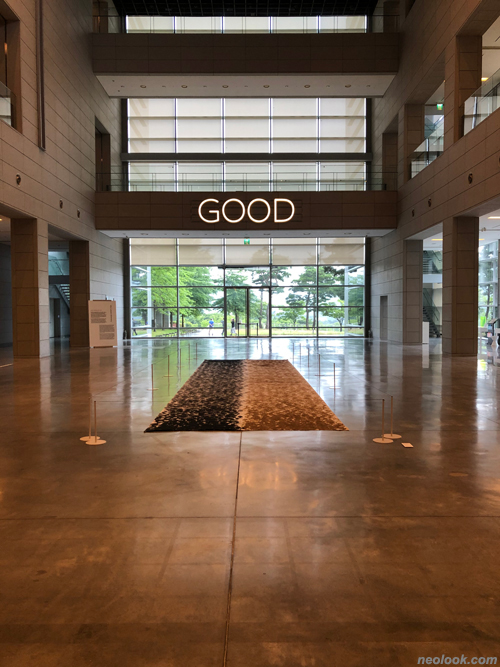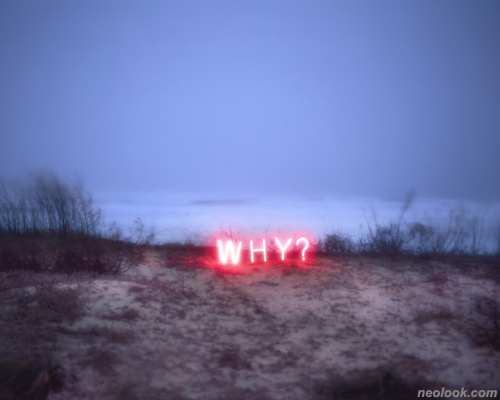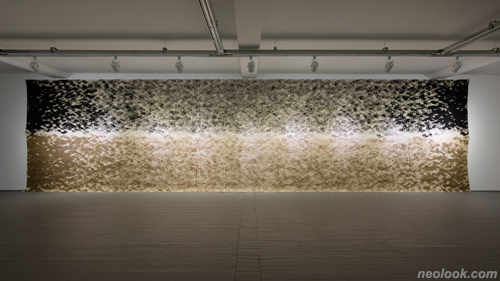- ● homepage
- ● archives
- ● restoration
- ● books
- ● big banners
- ● post board
- ■ neo's search
- ■ about us
- ■ 게재방법 안내
- 개인정보처리방침

- [email protected]
- Tel. 02_335_7922
- Fax. 02_335_7929
- 10:00am~04:30pm
- 월요일~금요일
- 3/3(월) 대체공휴일

대구포럼Ⅰ-시를 위한 놀이터
Daegu Forum Ⅰ-Playground for Poetry展 2021_0615 ▶ 2021_0926 / 월요일 휴관

- 대구포럼Ⅰ-시를 위한 놀이터展_대구미술관_2021
별도의 초대일시가 없습니다.
참여작가 박현기_백남준_이강소_이정 비아 레반도프스키_오쿠보 에이지 크베이 삼낭_히와 케이
관람시간 / 10:00am~06:00pm / 월요일 휴관 사전예약제 회차관람(현장입장 불가) 1시간 간격 입장, 회차별 130명 관람, 관람시간 제한없음 ▶ 사전예약(인터파크)후 방문 당일 입장권 현장수령 전화예약 / Tel. +82.(0)53.803.7907
대구미술관 DAEGU ART MUSEUM 대구시 수성구 미술관로 40 (삼덕동 374번지) 1 전시실, 어미홀 Tel. +82.(0)53.803.7900 artmuseum.daegu.go.kr
대구미술관은 올해 개관 10주년을 맞아 새로운 10년을 위한 주제 발굴 기획전 '대구포럼'을 신설하였다. 지속적인 학예연구를 바탕으로 대구미술관의 기획 방향을 제시할 대구포럼은 동시대 현대미술의 주요 흐름과 이슈를 창출하여 매년 국제적 수준의 전시를 관람객에게 선보인다. 그 배경에는 1970년대 대구현대미술제(1974-1979)의 역사적 순간을 떠올리고 새로운 세상을 향한 아방가르드들의 실험정신을 계승하려는 의지가 담겨있다. 『시를 위한 놀이터』는 그 서막을 여는 전시로, 예술의 본질에 대해 질문하는 데서 기획이 시작되었다. 상이한 문화적 배경 속에서 '시'라는 공통분모에 주목한 이번 전시는 절제된, 그러나 함축적인 조형 언어로 말을 거는 여덟 작가들을 시인에 비견하고자 했다.

- 박현기_도시의 지하철 역에서_영상설치_55×66cm_1997_대구미술관 소장

- 백남준_달에 사는 토끼_나무 토끼 조각, CRT TV 모니터 1대, 단채널 영상, 컬러, 무성, DVD_가변크기_1996_백남준아트센터 소장 ⓒ 백남준에스테이트
『시를 위한 놀이터』는 한 편의 '시(예술)'를 위해 시상을 찾는 예술가의 정신적 창작 행위, 그리고 그것이 시도되고 발현되는 장소로서 미술관의 가능성에 착안한 제목이다. 하나의 은유로서 '시'와 '놀이터'는 보는 시각에 따라 다르게 이해될 수 있다. 작가의 관점에서 보자면, 놀이터는 시(예술)가 탄생하기까지 무수한 사색과 상상, 치열한 도전과 실패, 때로는 무목적의 무용(無用)·무위(無爲)로 채워져 흔적이 남거나 흔적이 지워진 장소이며, 더 나아가 창작이 이뤄지는 영감의 장이다. 그리고 놀이는 예술가에게 있어 창조와 파괴, 재창조로 이어지는 창작의 바로 옆모습이다.

- 이강소_Becoming-11-C-096_세라믹_52×48×25cm_2011

- 이정_Why #3 From the Series Aporia_C 프린트_144×180cm_2016 Courtesy of the Artist
전시는 시의 다양한 외피를 입은 작품들을 소개한다. 시인이 언어로 이미지를 직조하듯 예술가는 물감으로, 흙으로, 영상으로, 또는 빛이나 TV로, 하나의 물성을 가진 유형의 언어를 만든다. 달은 가장 오래된 텔레비전이라 말한 백남준(1932~2006)은 어두운 밤하늘을 밝히는 달을 무한한 가능성을 지닌 텔레비전에 비유해 시간을 초월한 상상을 펼쳤다. 박현기(1942~2000)는 이태백의 함축적인 시구에 드러난, 대자연을 응축한 시인의 기백을 인공물에 비친 풍경에 담고자 했으며, 또한 우리의 감각과 지각이 공간에서 어떻게 반응하는지를 건축적 언어로 보여준다. 이강소(1943~)가 던진 흙덩이는 자유로운 붓질이 지나간 화면에 여백을 걷어낸 후의 정수(오브제)가 되었고, 어느 알 수 없는 적막한 자연 속에 외치듯이 때론 속삭이듯 불빛으로 표현된 이정(1972~)의 언어는 현대인의 감성을 네온사인으로 말한다. 이란과 이라크 국경에 위치한 쿠르드족 출신 히와 케이(Hiwa K, 1975~)는 두 발로 걸어서 고향을 떠나는 자신의 처지를 길가메시(인류 최초의 서사시로 알려진 길가메시 서사시의 주인공)에 비유해, 자신의 모국어만큼이나 소통되지 않는 언어를 어둠 속에서 시처럼 읊는다. '좋은 신(Good God)'은 어디 있는가? 1989년 베를린 장벽이 무너지기 직전 여러 국경을 넘어 베를린으로 이주한 동독 출신 작가 비아 레반도프스키(Via Lewandowsky, 1963~)의 질문이다. 캄보디아 작가 크베이 삼낭(Khvay Samnang, 1982~)은 땅과 종족의 본질적인 연결고리를 원시적 풍경 속에서 섬세한 신체의 움직임으로 표현한다. 일본의 1세대 대지 미술가 오쿠보 에이지(大久保英治, 1944~)는 마음의 친구 박현기와 이십여 년 만에 작품을 통해 조우한다. 이처럼 예술가의 삶과 기억, 미적 경험의 결정(結晶)인 작품은 가장 현실적인 이야기를 바탕으로 이루어진다. 시가 가장 추상적이고 함축적인 예술의 형태이나 그 단어를 낱낱이 나열하면 일상의 언어가 모여 구축된 것이듯 말이다.

- 비아 레반도프스키_GOOD GOD_네온, DMX 조명, 컨트롤_가변크기_2018(2021)

- 오쿠보 에이지_걷는 남자의 발_혼합재료_270×1,000cm_2019_시안미술관 소장
전시는 나아가 동시대 미술의 주요 주제인 신체와 정체성, 난민과 이주, 언어와 소통, 인간과 자연 등을 폭넓게 보여준다. 여덟 작가는 새로움을 향한 저항과 모험, 자유로운 실험정신을 기반으로, 때로는 은유와 유머를 통해 시대를 관통하는 날카로운 통찰을 드러낸다. 관람객은 전시장에서 한 편의 시를 위한 예술가의 호흡을 함께 느끼고 상상하며 마치 하나의 시처럼 전시를 읽게 되고, 마침내 자신만의 시를 품고서 전시장을 나서게 될 것이다. ■ 이정민

- 크베이 삼낭_영혼의 길_2채널 HD 영상, 사운드_00:18:43, 반복재생_2016~7 Courtesy of the Artist, Commissioned by documenta 14

- 히와 케이_Pre image(Blind as the Mother Tongue)_ 단채널 영상, 컬러, 사운드_00:18:00, 반복재생_2017 Courtesy the artist, KOW Berlin and Prometeogallery di Ida Pisani
In its 10th anniversary year, the Daegu Art Museum has founded the Daegu Forum, a theme-discovery exhibition for a new decade. The Daegu Forum, which will present the new curatorial direction of the museum based on continuous curatorial research, will annually present to viewers international-caliber exhibitions by creating major trends and issues of contemporary art. It holds in its background a will to think of the historic moment of the Daegu Contemporary Art Festival (1974-79) in the 1970s and inherit the experimental spirit of the avant-garde toward a new world. Playground for Poetry is an exhibition raising the curtains for this, and the planning began with asking questions about the purpose and essence of art. The exhibition, which focuses on different cultural backgrounds' common denominator of poetry, sought to compare to poets eight artists speaking to us in a succinct and suggestive visual language. ● The exhibition's title, Playground for Poetry, scrutinizes the creative act of an artist searching for poetic imagination for a piece of poetry (art) and the significance of a place of possibility where that is attempted and manifested. As metaphors, the words poetry and playground can be understood differently depending on the perspective. From the artist's perspective, a playground is a place filled with boundless inspiration and imagination, defiance and failure, and, sometimes, a purposeless uselessness or idleness until poetry (art) is created, so that traces remain or are erased; and, further, it is a place of inspiration where art-making takes place. Play, to the artist, is art-making's profile leading from creation to destruction and recreation. ● The exhibition introduces works wearing poetry's various skins. Just as poets create imagery through words, the artist creates a tangible language forming a unified texture using paint, clay, images, light, or TV. Nam June Paik (1932~2006), according to whom the moon is the oldest TV set, imagined things advanced for his time while viewing the moon, where the Tang Dynasty poet Li Bai once played. Hyun Ki Park (1942~2000) sought to include in scenery reflected in artifacts the poet's spirit of condensing great nature, which is revealed in the suggestive and succinct verses, and the artist uses architectural language to show how our senses and perceptions respond in space. Kang So Lee's clay lumps became the essence after removing the negative space on canvas where free brush strokes passed through, and the language of Jung Lee (1972~) expressed as light as if to alternate between shouting and whispering in an unknowable and desolate landscape speaks of sensibility and intimacy through neon light. The Kurdish Hiwa K (1982~), who is from the border area between Iran and Iraq, likens his situation of leaving his hometown on foot to that of Gilgamesh- the hero of The Epic of Gilgamesh, known as the world's first epic- and recites like poetry, in the dark, a language as incommunicable as his mother tongue. Where is the Good God? This question is from the formerly-East German artist Via Lewandowsky (1963~), who crossed four borders to finally settle in Berlin just before the Berlin Wall fell in 1989. The Cambodian artist Khvay Samnang (1982~) expresses the essential link between land and ethnicity through delicate physical movements in primitive scenery. Through this exhibition, Japan's first-generation land artist Eiji Okubo (1944~) greets his unforgotten friend Hyun Ki Park after over 20 years. In this way, abstract forms connoting the artist's life, memories, and aesthetic experiences are based on the real stories. It is as how poetry's individual words consist of everyday language despite poetry being the most abstract and implicit art form. ● This exhibition furthermore explores a wide range of contemporary art's major themes of the body and identity, refugees and migration, language and communication, and humans and nature. Based on resistance toward novelty, adventures, and a experimental spirit and sometimes through metaphor and humor, the eight artists reveal sharp insights penetrating their own era. Viewers will find themselves reading the exhibition like a poem as they collectively feel and imagine the artist's breath to create a piece of poetry, and they will finally exit the exhibition space with their own poetry in their hearts. I hope this exhibition will serve as an opportunity to find that the now 10-year-old Daegu Art Museum has established itself alongside the citizens as an art playground. ■ Jeongmin Lee
Vol.20210614f | 대구포럼Ⅰ-시를 위한 놀이터展
